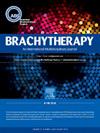Transition from point A to volume based image guided brachytherapy across a network of centers in India through workshop and mentoring
IF 1.7
4区 医学
Q4 ONCOLOGY
引用次数: 0
Abstract
AIM
To demonstrate how workshop and mentoring across a network of radiotherapy centers helped in transitioning from point A to volume-based image guided brachytherapy in carcinoma cervix.
MATERIALS AND METHODS
Based on discussion with different centers across the network, the lapses in cervical cancer treatment were identified and a workshop was designed to change the practice pattern. The main focus of the workshop was to streamline EBRT dose prescription protocols and implement volume based image guided brachytherapy through mentoring and hands on training. Patient data was analyzed 1 year post workshop to assess the impact in changing practice pattern.
RESULTS
A total of 246 cervical cancer patients treated with radical chemo radiotherapy and image guided brachytherapy were analyzed. 207 patients received CT based intracavitary brachytherapy whereas 39 patients received MR based hybrid brachytherapy. In patients who received EBRT and brachytherapy at the same center, the EBRT prescription dose was 45Gy in 25 fractions in 95% patients. The mean dose received by 90% of the HRCTV was 80.8Gy EQD2 in CT based intracavitary brachytherapy and 89.48Gy EQD2 in MR based hybrid brachytherapy. The mean bladder, rectum, sigmoid and small bowel D2cc doses were 63.87Gy, 62.18Gy, 61.2Gy and 55.1Gy EQD2 respectively.
CONCLUSION
This report demonstrates successful implementation and change of carcinoma cervix treatment practice pattern through workshop and mentoring across a network of radiotherapy centers in India.
通过研讨会和指导,从A点过渡到基于体积的图像引导近距离治疗,跨越印度的中心网络。
目的:展示研讨会和指导如何跨越放射治疗中心网络帮助从a点过渡到基于体积的图像引导近距离治疗宫颈癌。材料和方法:通过与网络上不同中心的讨论,确定了宫颈癌治疗的失误,并设计了一个研讨会来改变实践模式。研讨会的主要重点是简化EBRT剂量处方方案,并通过指导和实践培训实施基于体积的图像引导近距离治疗。研究人员分析了讲习班后1年的患者数据,以评估改变实践模式的影响。结果:对246例宫颈癌患者行根治性化疗和影像引导近距离放疗进行分析。207例患者接受基于CT的腔内近距离治疗,39例患者接受基于MR的混合近距离治疗。在同一中心接受EBRT和近距离治疗的患者中,95%的患者的EBRT处方剂量为45Gy,分为25个部分。90% HRCTV的平均剂量为:基于CT的腔内近距离治疗80.8Gy EQD2,基于MR的混合近距离治疗89.48Gy EQD2。膀胱、直肠、乙状结肠和小肠D2cc平均剂量分别为63.87Gy、62.18Gy、61.2Gy和55.1Gy。结论:本报告展示了通过研讨会和指导在印度的放疗中心网络成功实施和改变宫颈癌治疗实践模式。
本文章由计算机程序翻译,如有差异,请以英文原文为准。
求助全文
约1分钟内获得全文
求助全文
来源期刊

Brachytherapy
医学-核医学
CiteScore
3.40
自引率
21.10%
发文量
119
审稿时长
9.1 weeks
期刊介绍:
Brachytherapy is an international and multidisciplinary journal that publishes original peer-reviewed articles and selected reviews on the techniques and clinical applications of interstitial and intracavitary radiation in the management of cancers. Laboratory and experimental research relevant to clinical practice is also included. Related disciplines include medical physics, medical oncology, and radiation oncology and radiology. Brachytherapy publishes technical advances, original articles, reviews, and point/counterpoint on controversial issues. Original articles that address any aspect of brachytherapy are invited. Letters to the Editor-in-Chief are encouraged.
 求助内容:
求助内容: 应助结果提醒方式:
应助结果提醒方式:


